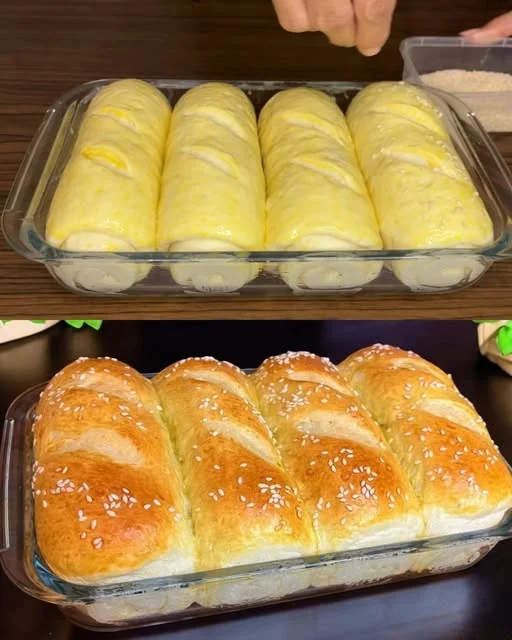Some recipes don’t just feed the body—they feed the soul. For me, soft milk bread is one of those rare dishes.
I still remember the smell of warm, sweet bread wafting through the air as a child. My grandmother used to make a simple milk bread on Sunday afternoons. She didn’t measure with scales or cups—just by feel, from memory, and always with care. It wasn’t fancy. There were no complicated folds, no glossy cookbook pages guiding the way. Just flour, milk, a bit of sugar, and her patient hands.
When I finally learned to bake on my own, milk bread was the first thing I tried to recreate. I wanted to relive that memory, to replicate the softness, the delicate sweetness, the warmth that made a slice of bread feel like a hug. After a few trials (and a couple of flat loaves), I found this version—and it brought everything back.
This is not just bread. It’s comfort. It’s simplicity. It’s a little piece of home you can bake in under two hours.
What Makes This Soft Milk Bread So Special?
Soft milk bread is known for its pillowy texture, subtle sweetness, and rich flavor. Unlike rustic sourdough or hearty whole wheat loaves, this bread leans into tenderness. It’s slightly sweet, golden on top, and almost cloud-like inside.
It’s often referred to as “Japanese milk bread” or “Hokkaido milk bread” in its fluffier iterations, but the version here is streamlined and accessible for every kitchen—no tangzhong, no kneading machines required.
Let’s explore what sets this recipe apart.
1. The Perfect Texture Without Fuss
This bread delivers a soft, almost melt-in-your-mouth crumb thanks to a combination of milk, powdered sugar, and butter. The addition of milk powder deepens the dairy flavor, and the use of warm milk as the liquid base gives the dough a head start toward becoming beautifully elastic.
You don’t need to be an expert baker to make this dough work. It’s forgiving, easy to handle, and a joy to shape. Once baked, the loaf pulls apart like a dream—no crumbling, no dry center. Just softness in every bite.
2. Balanced Sweetness
The flavor of this bread is gently sweet—not overly sugary like a dessert bread, but enough to make it feel indulgent even when eaten plain. That makes it versatile. You can serve it with jam and butter for breakfast, alongside soup for dinner, or even turn it into a base for sweet buns or French toast.
3. That Golden, Shiny Top
Brushing the top with egg yolk before baking gives the loaf a beautiful, golden-brown finish that feels straight out of a bakery window. It’s one small step that transforms a homemade bread into something that looks and tastes professional.
Ingredients Table – For the Bread
| Ingredient | Quantity | Notes |
|---|---|---|
| Warm milk | 150 ml (⅔ cup) | Around 38–40°C (100°F), not hot |
| Yeast | 6 g (2 teaspoons) | Instant or active dry |
| Wheat flour | 250 g (2 cups) | Use bread flour or all-purpose if needed |
| Powdered sugar | 50 g (¼ cup) | Adds subtle sweetness |
| Salt | ¼ teaspoon | Enhances flavor |
| Milk powder | 10 g (1 tablespoon) | Optional, but adds richness |
| Unsalted butter | 15 g (1 tablespoon) | Softened |
| Egg yolk | 1 | For brushing the top before baking |
Directions
- Activate the Yeast
Mix warm milk and yeast in a bowl. Let sit for 5–10 minutes until foamy (if using active dry yeast). - Form the Dough
In a large bowl, combine flour, powdered sugar, salt, and milk powder. Add the yeast mixture and mix until a soft dough forms. Knead until smooth and elastic (about 8–10 minutes by hand or 5 minutes with a stand mixer). - Add the Butter
Knead in the softened butter until fully absorbed and the dough is smooth and slightly tacky. - First Rise
Cover the dough and let it rise in a warm place for about 1 hour, or until doubled in size. - Shape and Proof
Punch down the dough, shape into a loaf or rolls, and place into a greased pan. Cover and let rise again for 30–45 minutes. - Brush and Bake
Preheat oven to 180°C (350°F). Brush the top with egg yolk. Bake for 20–25 minutes until golden brown and hollow-sounding when tapped. - Cool and Serve
Let cool on a wire rack before slicing. Best enjoyed warm or lightly toasted.
Nutritional Information (Per Slice – Approx. 1 of 10 slices)
| Nutrient | Amount (Approx.) |
|---|---|
| Calories | ~160 kcal |
| Protein | 4 g |
| Carbohydrates | 26 g |
| Sugars | 5 g |
| Fat | 4 g |
| Fiber | 0.8 g |
| Sodium | ~90 mg |
How to Use It: From Breakfast to Dessert
One of the best things about soft milk bread is how many ways you can use it. It’s neutral enough to go sweet or savory, but always feels special. Here are a few ideas to get the most from your loaf:
Breakfast
- Toasted and slathered with butter and honey
- Topped with avocado and a poached egg
- As the base for a breakfast sandwich with scrambled eggs and cheese
Lunch
- Sliced thick for grilled cheese
- Served with tomato soup or chowder
- Pressed into paninis with deli meats and veggies
Snack or Dinner
- Used as dinner rolls or buns for sliders
- Dipped into olive oil and herbs
- Paired with a cheese board or soft dips
Dessert
- Made into sweet milk bread pudding
- Turned into French toast or stuffed French toast
- Layered with whipped cream and fruit for a trifle base
The possibilities are endless. And because this bread stays soft for a couple of days, it’s perfect for making ahead or gifting.
Why It Belongs in Every Home Baker’s Recipe Box
If you’ve ever been intimidated by bread baking, this is the loaf to try. There’s no sourdough starter to feed, no hours-long fermentation to track, and no complicated shaping technique. It’s quick, reliable, and delightfully satisfying.
This is the kind of recipe you’ll reach for again and again—when you want to fill your home with the scent of fresh bread, when you need something soft and lovely for your kids’ lunches, or when you just want to slow down and make something warm with your hands.
It teaches the joy of baking without the stress. And that’s something every kitchen can use.
Frequently Asked Questions (FAQs)
Can I make this bread without milk powder?
Yes. Milk powder is optional, though it adds a rich, creamy note to the dough. If you don’t have it, simply leave it out—your bread will still be soft and flavorful.
Can I use all-purpose flour instead of wheat flour?
Yes, you can use all-purpose flour or bread flour. Whole wheat flour can also be used for a heartier version, but it will make the loaf slightly denser. For the softest crumb, stick with refined wheat or bread flour.
Do I have to use egg yolk on top?
Not necessarily. The egg yolk gives the bread its golden, glossy finish. If you’re avoiding eggs, you can brush the top with milk or a milk + oil mixture instead. It won’t be as glossy, but it will still brown nicely.
How do I know when the bread is done?
The loaf should be golden brown on top and sound hollow when tapped. If using a thermometer, the internal temperature should be about 190°F (88°C). Let it cool on a wire rack before slicing for the best texture.
How long does this bread stay fresh?
Soft milk bread stays fresh for 2–3 days at room temperature when stored in an airtight container or wrapped in a towel. For longer storage, slice and freeze the bread. Reheat in the toaster or oven as needed.
Can I add flavors or fillings?
Yes! This dough is very versatile. Here are a few ideas:
- Sweet versions: Add cinnamon, raisins, chocolate chips, or swirl in jam before shaping.
- Savory versions: Add shredded cheese, herbs, or chopped olives.
- Filled rolls: Divide the dough into smaller pieces and fill with custard, red bean paste, Nutella, or cream cheese for stuffed buns.
Can I knead the dough by hand?
Definitely. It may take a bit more effort—about 8–10 minutes of hand kneading—but it’s a satisfying process and works beautifully. Just knead until the dough is smooth, elastic, and slightly tacky.
Tips for the Best Soft Milk Bread Every Time
- Warm your milk, not hot. If it’s too hot, it can kill the yeast. Aim for lukewarm—just warm to the touch.
- Let the dough rise fully. Don’t rush it. Wait until the dough has doubled in size during both rises. This is key to the bread’s soft texture.
- Use fresh yeast. Expired yeast can prevent your dough from rising properly. Always test if unsure.
- Brush just before baking. Applying the egg yolk right before placing the loaf in the oven ensures a rich, shiny finish.
Why I Keep Coming Back to This Recipe
There are days when we crave complexity—multi-step meals, layered flavors, culinary challenges. But there are also days when we just want something pure and comforting. Something that reminds us of warmth and care and home.
This bread is for those days.
It’s the recipe I make when I want my house to feel like a bakery. When I need something soft and grounding. When I want to slow down without stopping completely.
It’s my quiet rebellion against the rush of everyday life.
And it’s also really, really delicious.
Conclusion: Bread That Feeds More Than Hunger
Soft milk bread isn’t just about food—it’s about feeling. It’s about connection, memory, and nourishment in every sense of the word.
This recipe is simple enough for beginners, rewarding enough for seasoned bakers, and comforting enough to become a household staple. Whether you’re baking for your family, your friends, or just for yourself, this loaf brings a little joy with every slice.
So if you’ve ever thought, “I don’t have time to bake,” or “I’m not a bread person,” let this recipe change your mind.
Because once you taste what a handful of ingredients and a warm oven can create—you may never go back to store-bought bread again.


